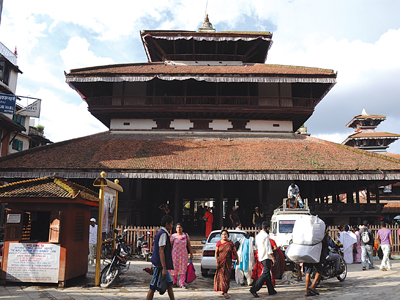Somewhere in the distance a bell rings as a woman dressed in a red sari lights a ghee (butter) lamp. A young girl runs through a crowd of pigeons and the birds explode into the air, dispersing themselves on nearby rooftops. Near the girl, a group of vegetable peddlers has laid claim to a small patch of pavement: on top of their tarps are organized pyramids of tomatoes, cucumbers and potatoes. Above the activity on the ground looms the majestic Kasthamandap (Kastha: wood, mandap: pavilion) Temple, one of the oldest and most striking buildings in Kathmandu. The building is a preserved relic from the past and a testament to Nepal’s centuries-old architectural style.

Legend has it that the architectural masterpiece, Kasthamandap, was built out of a single Sal tree and has neither nails nor rivets holding it together
Legend has it that the wooden Kasthamandap temple, also known as “Maru Satal”, was constructed out of a single Sal tree. The Sal tree, native to the South Asian region, produces an especially hard variety of wood, good for long-lasting structures. To this day, Kasthamandap is said to have no metal nails or rivets holding it together.
Kasthamandap’s ornate roof blossoms out from a single spire into three layers: the smallest on the top level to the largest on the bottom. The temple, like many other buildings in Kathmandu’s Durbar Square, was built in traditional pagoda style, an architectural design that is often synonymous with religion in South and Southeast Asia. The pagoda-style architecture emerged from India in the 3rd century and has since spread not only to Nepal, but also to Myanmar, Korea, Japan and beyond.
The pagoda-style roof of Kasthamandap is, perhaps, one of the most awe-inspiring aspects of the temple: each one of the three roof levels are meticulously layered with faded terracotta tiles. The building is surrounded by a grandiose, carved wood banister, which should be closely inspected by visitors to understand the care given to wood carving in 16th-century Nepal. The tradition of handcrafted wood pieces carries on today: the handiwork can be seen in wood shops all over the Kathmandu Valley, especially around Kathmandu and Patan Durbar Squares.
With a bit of imagination, while gazing upon Kasthamandap’s ancient splendor and sprawling pagoda roof-top, it’s easy to image Kathmandu as it was over 400 years ago when the complex was built. Although structures in Kathmandu have largely morphed into more Western (and concrete) styles, Kasthamandap’s artistic construction remains an important testament of Nepal’s rich cultural heritage in terms of building design. The preservation of the wooden temple’s cultural and aesthetic value is a priority both locally and internationally as Kasthamandap is part of the UNESCO World Heritage Site of Kathmandu Durbar Square.









